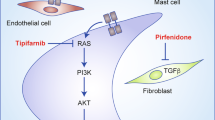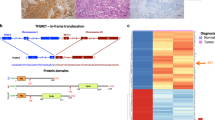Abstract
Mutations of the RET proto-oncogene are found in the majority of patients with the inherited cancer syndrome multiple endocrine neoplasia type 2 (MEN 2). A minority of cases, however, have no detectable RET mutation and there is considerable phenotypic variation within and among MEN 2 families with the same RET mutation, suggesting a role for other loci in this disease. A candidate for such a gene is glial cell line-derived neurotrophic factor receptor alpha 4 (GFRA4), which encodes a cell surface-bound co-receptor (GFRα4) required for interaction of RET with its ligand persephin. The GFRA4 gene has multiple alternative splices leading to three distinct protein isoforms that are prominently expressed in thyroid. We postulated that mutations of GFRA4 contribute to MEN 2 in the absence of RET mutations or modify the RET mutation phenotype. We screened patients with MEN 2 or MEN 2-like phenotypes, with and without RET mutations, for variants of GFRA4. We identified 10 variants, one of which was over represented in, and two of which were found exclusively in, our patient populations. One of these was a single-base substitution upstream of the GFRα4 coding region, where it may alter gene expression. The second was a 7 bp insertion, which results in a change in reading frame for all three GFRα4 isoforms. This would cause a relative shift in membrane bound and soluble forms of GFRα4, which would significantly alter the formation of RET signalling complexes. Our data suggest a model of wild-type GFRα4 isoform expression that includes both activating and inhibiting co-receptors for RET.
This is a preview of subscription content, access via your institution
Access options
Subscribe to this journal
Receive 50 print issues and online access
$259.00 per year
only $5.18 per issue
Buy this article
- Purchase on Springer Link
- Instant access to full article PDF
Prices may be subject to local taxes which are calculated during checkout



Similar content being viewed by others
References
Airaksinen MS, Titievsky A and Saarma M . (1999). Mol. Cell. Neurosci., 13, 313–325.
Avantaggiato V, Dathan NA, Grieco M, Fabien N, Lazzaro D, Fusco A, Simeone A and Santoro M . (1994). Cell Growth Differ., 5, 305–311.
Babu VR, Van Dyke DL and Jackson CE . (1984). Proc. Natl. Acad. Sci. USA, 81, 2525–2528.
Baloh RH, Enomoto H, Johnson Jr EM and Milbrandt J . (2000). Curr. Opin. Neurobiol., 10, 103–110.
Enokido Y, de Sauvage F, Hongo JA, Ninkina N, Rosenthal A, Buchman VL and Davies AM . (1998). Curr. Biol., 8, 1019–1022.
Feldman GL, Edmonds MW, Ainsworth PJ, Schuffenecker I, Lenoir GM, Saxe AW, Talpos GB, Roberson J, Petrucelli N and Jackson CE . (2000). Surgery, 128, 93–98.
Frohnauer MK and Decker RA . (2000). Surgery, 128, 1052–1058.
Gil L, Azanedo M, Pollan M, Cristobal E, Arribas B, Garcia-Albert L, Garcia-Saiz A, Maestro ML, Torres A, Menarguez J and Rojas JM . (2002). Int. J. Cancer, 99, 299–304.
Gimm O, Dziema H, Brown J, Hoang-Vu C, Hinze R, Dralle H, Mulligan LM and Eng C . (2001). Oncogene, 20, 2161–2170.
Hansford JR and Mulligan LM . (2000). J. Med. Genet., 37, 817–827.
Hansford JR, Samson SL, Naumovski D, Vanhorne JB and Mulligan LM . (2001). Am. J. Hum. Genet., 69S, 366.
Lindahl M, Poteryaev D, Yu L, Arumae U, Timmusk T, Bongarzone I, Aiello A, Pierotti MA, Airaksinen MS and Saarma M . (2001). J. Biol. Chem., 276, 9344–9351.
Lindahl M, Timmusk T, Rossi J, Saarma M and Airaksinen MS . (2000). Mol. Cell. Neurosci., 15, 522–533.
Lombardo F, Baudin E, Chiefari E, Arturi F, Bardet S, Caillou B, Conte C, Dallapiccola B, Giuffrida D, Bidart JM, Schlumberger M and Filetti S . (2002). J. Clin. Endocrinol. Metab., 87, 1674–1680.
Masure S, Cik M, Hoefnagel E, Nosrat CA, Van Der Linden I, Scott R, Van Gompel P, Lesage AS, Verhasselt P, Ibanez CF and Gordon RD . (2000). J. Biol. Chem., 275, 39427–39434.
Mulligan LM, Gardner E, Smith BA, Mathew CGP and Ponder BAJ . (1993). Genes Chromosomes Cancer, 6, 166–177.
Nakamura T, Ishizaka Y, Nagao M, Hara M and Ishikawa T . (1994). J. Pathol., 172, 255–260.
Sanicola M, Hession C, Worley D, Carmillo P, Ehrenfels C, Walus L, Robinson S, Jarworski G, Wei H, Tizard R, Whitty A, Pepinsky RB and Cate RL . (1997). Proc. Natl. Acad. Sci. USA, 94, 6238–6243.
Scott RP and Ibáñez CF . (2001). J. Biol. Chem., 276, 1450–1458.
Shannon KE, Gimm O, Hinze R, Dralle H and Eng C . (1999). J. Endocr. Genet., 1, 39–46.
Trupp M, Raynoschek C, Belluardo N and Ibanez CF . (1998). Mol. Cell. Neurosci., 11, 47–63.
Van Dyke DL, Babu VR and Jackson CE . (1984). Henry Ford Hosp. Med. J., 32, 266–268.
Vanhorne JB, Gimm O, Myers SM, Kaushik A, von Deimling A, Eng C and Mulligan LM . (2001). Hum. Genet., 108, 409–415.
Wiench M, Wygoda Z, Gubala E, Wloch J, Lisowska K, Krassowski J, Scieglinska D, Fiszer-Kierzkowska A, Lange D, Kula D, Zeman M, Roskosz J, Kukulska A, Krawczyk Z and Jarzab B . (2001). J. Clin. Oncol., 19, 1374–1380.
Acknowledgements
We thank the patients and families, clinicians and geneticists who contributed to this study. We thank Andrew Day and Shirley Myers for their assistance. This work was supported the Canadian Institutes of Health Research and the Hospital for Sick Children Foundation (LMM), Queen's University (KJH) and a fellowship from the National Cancer Institute of Canada (SDA).
Author information
Authors and Affiliations
Corresponding author
Rights and permissions
About this article
Cite this article
Vanhorne, J., Andrew, S., Harrison, K. et al. A model for GFRα4 function and a potential modifying role in multiple endocrine neoplasia 2. Oncogene 24, 1091–1097 (2005). https://doi.org/10.1038/sj.onc.1207826
Received:
Revised:
Accepted:
Published:
Issue Date:
DOI: https://doi.org/10.1038/sj.onc.1207826
Keywords
This article is cited by
-
Glial cell line-derived neurotrophic factors (GFLs) and small molecules targeting RET receptor for the treatment of pain and Parkinson’s disease
Cell and Tissue Research (2020)
-
The mouse soluble GFRα4 receptor activates RET independently of its ligand persephin
Oncogene (2007)
-
RET Signaling in Endocrine Tumors: Delving Deeper into Molecular Mechanisms
Endocrine Pathology (2007)
-
Molecular genetics of multiple endocrine neoplasia types 1 and 2
Nature Reviews Cancer (2005)



